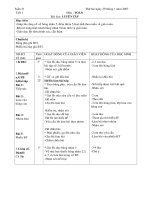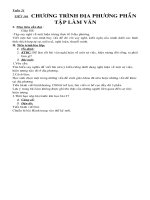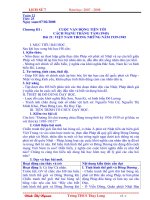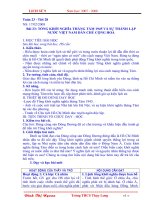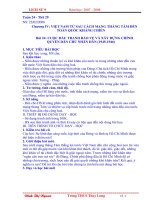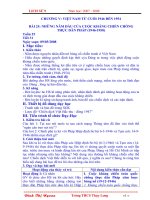- Trang chủ >>
- THPT Quốc Gia >>
- Ngoại Ngữ
lop 9 tuan 21
Bạn đang xem bản rút gọn của tài liệu. Xem và tải ngay bản đầy đủ của tài liệu tại đây (138.55 KB, 4 trang )
<span class='text_page_counter'>(1)</span>Planning date: 10/ 01/ 2014 Period: 39. Teaching date: 14/ 01/ 2014 UNIT 6 : THE ENVIRONMENT READ. I. Objectives: - By the end of this lesson, Ss will be able to understand the poem about the environmental problem. 1. Knowledge: a. Vocabulary: Related to the environment b. Grammar: Conditional sentence type 1. 2. Skills: Reading, less speaking, listening and writing. 3. Attitude: Ss will be educated about how to protect the environment. II. Teaching methods: - Communicative approach. - Techniques: Eliciting, explanation, asking, answering, individual work, pairwork. III. Teaching aids: a. Teacher: Book, lesson plan, aiding board, colored chalks, smart pen. b. Students: Notebook, book, pen, ruler ... IV. Procedures: 1. Greeting and taking attendance (1’) 2. Preview of the previous lesson (4’) - T calls one pair of Ss to make conversation to persuade their partners to do something to protect the environment. 3. New lesson (35’) Teacher’s and students’ activities - Teacher asks, Ss answer the questions.. Content * Warm up “Chatting” - Have you ever polluted the environment? - How did you do? - What should you do to protect the environment? - Have you ever ask your relatives to save the environment? - T introduces the content of the poem: “A 1. Read mother and her son are having a picnic in the * Pre – Reading park. The son sees that the place is polluted. He asks his mother about the problems of pollution. What does the mother think about the pollution?” - T plays the tape once. * While - Reading a. Match each word in A to an appropriate - Ss listen to the tape. - T helps Ss know the way how to read the explanation in B. A B poem : 1-2, 3-4-5-6, 7-8, 9-10, 11-12?-13-14-151. junk-yard a. a row of things forming a 16. fence. - T has Ss read the poem in silience 2. end up b. people And do exercise a. 3. treasure c. a piece of land full of rubbish - Ss compare the answers in pairs. - Ss give the answers before the class. - T checks and corrects the answers as well as introduces and explains new words. - Ss practices reading new words..
<span class='text_page_counter'>(2)</span> Teacher’s and students’ activities - Some Ss read new words before the class. - T corrects students’ pronunciation if necessary. - T gets Ss read the poem and ask, answer the questions in pairs. - Some pairs of Ss ask and answer the questions before the class. - T checks and corrects the answers. - Ss copy down the answers in their notebooks.. - T asks, Ss answer the questions.. Content 4. foam d. a flow of water 5. stream e. mass of bubbles 6. hedge f. valuable or precious things 7. folk g. reach a state of Keys: 1-c, 2-g, 3-f, 4-e, 5-d, 6-a, 7-b b. Answer. Then write the answers in your exercises book. Keys : 1. If the pollution goes on, the world will end up like a second hand junk-yard. 2. She thinks other folk pollute the environment except her and her son. 3. If the boy keeps on asking such questions, his mother will take him hom right away. 4. No, because he is right. If he throws the bottles that will be polluting the woods. 5. The poet wants us to learn that everyone is responsible for keeping the environment from pollution / stopping pollution. 6. Students’ answers. Ex: - Put the garbage bins around the schoolyards. - Pick up the rubbish? garbage and put into the rush bin. * Post – Reading What can you learn from this poem?. 4. Consolidation (4’) T calls some Ss read the poem before the class exactly, then answer the questions : a. What does the poet want us to learn about keeping the environment un polluted ? b. What can you do at school/ your hourses to minimize pollution ? 5. Homework (1’) Ss learn new words, practice reading the poem and prepare lesson “Write”. V. Experience: ……………………………………………………………………………………………………………………………………………………………………… ……………………………………………………………………………………………………………………………………………………………………… ………………………………………………………………………………………………………………………………………………………………………. Planning date: 10/ 01/ 2014 Period: 40. Teaching date: 18/ 01/ 2014 UNIT 6 : THE ENVIRONMENT WRITE. I. Objectives: - By the end of this lesson, Ss will be able to improve their writing skill : know how to write and practice writing a complaint letter. 1. Knowledge: a. Vocabulary: Related to the environment. b. Grammar: I would suggest that your company should tell your drivers to clear up all the trash on the ground before leaving..
<span class='text_page_counter'>(3)</span> 2. Skills: writing, less reading, speaking and listening. 3. Attitude: Ss will be educated about how to protect the environment. II. Teaching methods: - Communicative approach. - Techniques: Eliciting, explanation, asking, answering, individual work, pairwork. III. Teaching aids: a. Teacher: Book, lesson plan, aiding board, colored chalks, smart pen. b. Students: Notebook, book, pen, ruler ... IV. Procedures: 1. Greeting and taking attendance (1’) 2. Preview of the previous lesson (4’) T calls one S to read the letter loudly and fluently. Then answer the questions: a. What does the poet want us to learn about keeping the environment unpolluted? b. What can you do to minimize pollution at home / at school? 3. New lesson (35’) Teacher’s and students’ activities. Content * Warm up Play game “Jumble Words” - T asks Ss to play game “Jumble Words ”. - Baegarg (garbage) - Students play game. - Erlitt (litter) - T checks and corrects the answers. - Tipololun (pollution) - Cleyrec (recycle) * Pre – Writing - T explains the structures of a complaint Structures of a complaint letter. letter . * Situation - Ss pay attention to teacher and take notes. States the reason for writing. * Complication Mentions the problem * Resolution Makes the suggestion * Action Talks about future action * Politeness Ends the letter politely - T explains the requirement of exercise a. a. Label each section with the letters. - Ss read the letter in silience and do exercise Keys : R / S / A / C / P a. Then compare the answers in pairs. - T calls some Ss to give the answers before the class. - T checks and corrects the answers. - T explains the requirement of exercise b. b. Write a letter to the head of the local - T introduces and explains new words. authorities to complain about the way of catching - Ss practice reading new words. fish in the lake behind your house. - Some Ss read new words before the class. Vocabulary : - T corrects students’ pronunciation if - Complaint (n) necessary. - Complication (n) - T introduces the main ideas for writing in - Resolution (n) the cues and has Ss write a complaint letter. - Prohibit (v) - Authority (n) - Frog (n) - Float (v).
<span class='text_page_counter'>(4)</span> - Ss write a complaint letter. - Ss compare their writing in pairs. - S calls some Ss read the letters before the class. - T checks and corrects any mistakes if necessary. - Ss copy down the correct letter.. - T asks, Ss answer the question.. * While - writing Situation of a letter Dear Mr. President, I’m writing to you about the problem of fish catching in the lake behind my house. Complication I’m very worried because people are using electricity to catch fish. A lot of small fish have died and floated on the surface of water. Other animals such as frogs, toads, and even birds have also died from electric shock waves. Resolution and Action I would suggest that the local authorities have measures to stop this and to prohibit and fine heavily those who use this way to catch fish in order to protect the environment. Politeness I’m looking forward to hearing from you and seeing your immediate response. *Post – Writing Have you ever seen or heard any actions like this in your hometown ? If yes, What would you do ?. 4. Consolidation (4’) T emphasizes the ways to write a complaint letter by asking them questions: a. In which case do we write a complaint letter? b. How many sections are there in a complaint letter? c. What are they? 5. Homework (1’) Ss learn the way to write a complaint letter, practice writing a complaint letter and prepare lesson: Language focus. V. Experience: ……………………………………………………………………………………………………………………………………………………………………… ……………………………………………………………………………………………………………………………………………………………………… ………………………………………………………………………………………………………………………………………………………………………. Signature Week 21 ………………………………………………..
<span class='text_page_counter'>(5)</span>
